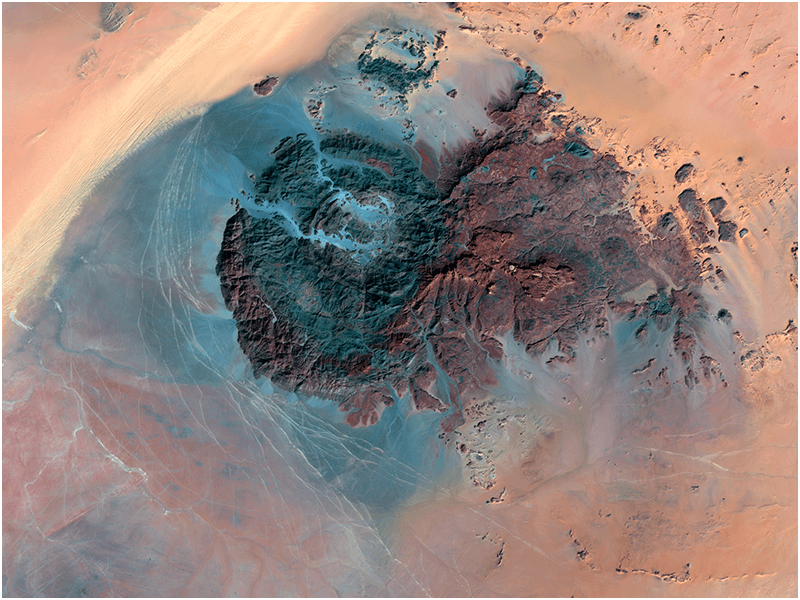The Gilf El-Kebir is a sandstone plateau located in the southwest corner of the Western Desert.
The rocky surface slopes south-eastward are partially covered by sand because the Great Sand Sea to the north is gradually encroaching on the plateau.
The area is dry and empty but it supports many great creatures like Barbary Sheep, and several species of reptiles as well as small birds.
It is really a beautiful place to discover as you can see ancient rock art in Shaw’s Cave and El-Mestikawi cave that has evidence about the existence of many types of cattle that attest to a wetter period in prehistoric times.
The best time to visit Gilf El-Kebir from October to May as they are the cooler months of the year, it is very hard to go there in summer as the temperature approximately can reach 35 – 45 c.
There was a novel called ( The English Patient ) written by Michael Ondaatje, he mentioned that there was a bag which had been lost in the Second World War by a dispatch rider (Alec Ross) of the Long Range Desert Group, part of the British Army. This contained the rider’s
personal letters and photographs and had been well preserved.

The Gilf Kebir is famous for its prehistoric (Neolithic) petroglyphs:
-Karkur Talh and Karkur Murr: The main eastern valleys of the Uweinat that contains one of the richest concentrations of rock art in the whole Sahara.
-Western Uweinat: It contains shelters under the huge granite rocks beside several beautiful paintings in the western including the famous sites of Ain Doua.
– Jebel Arkenu, Jebel Kissu & Yerguehda Hill, the lesser amount of granite.
– Mogharet El Kantara in the southern Gilf Kebir it contains only one known art site a cave discovered by Shaw & party in 1936.
-Wadi Sora, it located in the northwestern Gilf Kebir, the best thing about that site it is a special site for swimmers a swimmer’s cave.
-In January 2003, Zarzora Expeditions and Jacopo Foggini independently announced the discovery of a major new rock art site in the Western Gilf Kebir (Foggini-Mestekawi Cave).

The Uwaynat Desert:
In recent years the southwestern portion of the Western Desert has been given the name the Uwaynat Desert.
It is the counterweight to the Darb al-Arabian Desert in the southeast.
It begins in the east around Bir Tarfawi, runs north to Dakhla Oasis and the Great Sand Sea, flows out of Egypt into Libya in the west and creeps into Sudan in the south.
The Uwaynat Desert is pocked with craters and granite mountains.
It is also one of the few places in Egypt where you can see the Precambrian basement rock.
If you attend to go there be careful to choose a guide that knows the area well to be confident when exploring the area.

Zerzura Oasis
It is a mysterious Oasis located within the haunting interior of the Libyan, people called it the lost oasis of Zerzura.
In the past, many people searched for it and lain down their lives to find it.But never found it.
The first mention for Zerzura was by the medieval Arab traveler Uthman al-Nabulsi in 1447.
The second time is in the fifteenth-century Book of Hidden Pearls.
In this time (the Middle Ages). Buried treasure became a mania, This book (Hidden Pearls) gave over four hundred sites where buried treasure could be found in Egypt.
Anyone who was lucky enough to come across one of these books guarded it with his life, of
which he spent a good part trying to decipher the magic formulae, maps, and instructions.
Ibn Khaldun related how Berber students from the Maghrib, who were studying in Cairo, tried to sell counterfeit treasure documents to wealthy Cairenes, including The Book of Hidden Pearls.
It created such a mania and so many ancient monuments were attacked that in the nineteenth century Maspero, the curator of the Egyptian Museum, agreed to have the book translated into French to put an end to the speculation.
It was translated by Ahmad Kamal and published in 1907 by the IFAO under the title Livre des Perles Enfouies.
An index to the book was published a few decades later in the Bulletin de la Societe Royale Geographic d’ Egypt.
This place also contains a city called The City of Wardabaha states located behind the citadel of al-Suri, you will find palms, vines, and springs.
Egypt, written in 1835, mentions a number of unknown and mysterious places and gives their approximate location. He said the people of Dakhla told him of Zerzura. but it still a legend for many.


